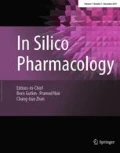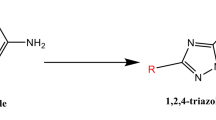Abstract
Both DHPS (dihydropteroate synthase) and DHFR (dihydrofolate reductase) play important physiological roles in the survivability of Mycobacterium tuberculosis (MTB). Sulfonamides are the potent drugs to monitor growth and proliferation of MTBs by inhibiting the activity of DHPS and DHFR which could explain the mechanism of action of these molecules. In this work, 102 heterocyclic sulfonamides (HSF) have been screened by discovery studio molecular docking programme to search the best suitable molecule for the treatment of MTBs. Lipinski’s rule of five protocols is followed to screen drug likeness of these molecules and ADMET (absorption, distribution, metabolism, excretion and toxicity) filtration has been used to value their toxicity. Only fourteen molecules are found to obey the Lipinski’s rule and able to cross the ADMET filter. A small difference between HOMO and LUMO energy signifies the electronic excitation energy which is essential to calculate molecular reactivity and stability of the best docked compound and easy activation of drug in the protein environment. Both 4-amino-N-(6-hydroxypyridin-2-yl)benzenesulfonamide (M1) and 4-amino-N-(9H-carbazol-2-yl)benzenesulfonamide (M2) show the best theoretical efficiency with DHPS and DHFR, respectively. These compounds are also found to bind to the adenine–thymine region of tuberculosis DNA.










Similar content being viewed by others
References
Ajay, Bemis GW, Murcko MA (1999) Designing libraries with CNS activity. J Med Chem 42(24):4942–4951
Ames BN, Gurney EG, Miller JA, Bartsch H (1972) Carcinogens as frameshift mutagens: metabolites and derivatives of 2-acetylaminofluorene and other aromatic amine carcinogens. Proc Natl Acad Sci USA 69(11):3128–3132
Becke AD (1993) Density-functional thermochemistry. I. The role of exact exchange. J Chem Phys 98(7):5648–5652
Cheah H-L, Lim V, Sandai D (2014) Inhibitors of the glyoxylate cycle enzyme ICL1 in Candida albicans for potential use as antifungal agents. PLoS One 9(4):e95951
Cheng F, Li W, Zhou Y, Shen J, Wu Z, Liu G, Lee PW, Tang Y (2012) admetSAR: a comprehensive source and free tool for assessment of chemical ADMET properties. J Chem Inf Model 52(11):3099–3105
Chung BK, Dick T, Lee DY (2013) In silico analyses for the discovery of tuberculosis drug targets. J Antimicrob Chemother 68(12):2701–2709
Finch A, Pillans P (2014) P-glycoprotein and its role in drug–drug interactions. Aust Prescr 37(4):137–139
Freilich EB, Coe GC, Wien NA (1939) The use of sulfanilamide in pulmonary tuberculosis; preliminary report. Ann Intern Med 13(6):1042–1045
Frisch MJ, Trucks GW, Schlegel HB, Scuseria GE, Robb MA, Cheeseman JR, Scalmani G, Barone V, Mennucci B, Petersson GA, Nakatsuji H, Caricato M, Li X, Hratchian HP, Izmaylov AF, Bloino J, Zheng G, Sonnenberg JL, Hada M, Ehara M, Toyota K, Fukuda R, Hasegawa J, Ishida M, Nakajima T, Honda Y, Kitao O, Nakai H, Vreven T, Montgomery JA Jr, Peralta JE, Ogliaro F, Bearpark MJ, Heyd J, Brothers EN, Kudin KN, Staroverov VN, Kobayashi R, Normand J, Raghavachari K, Rendell AP, Burant JC, Iyengar SS, Tomasi J, Cossi M, Rega N, Millam NJ, Klene M, Knox JE, Cross JB, Bakken V, Adamo C, Jaramillo J, Gomperts R, Stratmann RE, Yazyev O, Austin AJ, Cammi R, Pomelli C, Ochterski JW, Martin RL, Morokuma K, Zakrzewski VG, Voth GA, Salvador P, Dannenberg JJ, Dapprich S, Daniels AD, Farkas Ö, Foresman JB, Ortiz JV, Cioslowski J, Fox DJ (2009) Gaussian 09. Gaussian Inc., Wallingford
Gill PM, Johnson BG, Pople JA, Frisch MJ (1992) The performance of the Becke–Lee–Yang–Parr (B–LYP) density functional theory with various basis sets. Chem Phys Lett 197(4–5):499–505
Hou T, Wang J (2008) Structure—ADME relationship: still a long way to go? Expert Opin drug Metab Toxicol 4(6):759–770
Lionta E, Spyrou G, Vassilatis DK, Cournia Z (2014) Structure-based virtual screening for drug discovery: principles, applications and recent advances. Curr Top Med Chem 14(16):1923–1938
Lipinski CA, Lombardo F, Dominy BW, Feeney PJ (2001) Experimental and computational approaches to estimate solubility and permeability in drug discovery and development settings. Adv Drug Deliv Rev 46(1–3):3–26
Masters PA, O’Bryan TA, Zurlo J, Miller DQ, Joshi N (2003) Trimethoprim–sulfamethoxazole revisited. Arch Intern Med 163(4):402–410
Minato Y, Thiede JM, Kordus SL, McKlveen EJ, Turman BJ, Baughn AD (2015) Mycobacterium tuberculosis folate metabolism and the mechanistic basis for para-aminosalicylic acid susceptibility and resistance. Antimicrob Agents Chemother 59(9):5097–5106
Mitcheson JS (2008) hERG potassium channels and the structural basis of drug-induced arrhythmias. Chem Res Toxicol 21(5):1005–1010
Mortelmans K, Zeiger E (2000) The Ames Salmonella/microsome mutagenicity assay. Mutat Res 455(1–2):29–60
Myers S, Baker A (2001) Drug discovery—an operating model for a new era. Nat Biotechnol 19(8):727–730
O’Hagan S, Kell DB (2015) The apparent permeabilities of Caco-2 cells to marketed drugs: magnitude, and independence from both biophysical properties and endogenite similarities. PeerJ 3:e1405
Palomino JC, Martin A (2016) The potential role of trimethoprim–sulfamethoxazole in the treatment of drug-resistant tuberculosis. Future Microbiol 11(4):539–547
Pradhan S, Mondal S, Sinha C (2016) In search of Tuberculosis drug design: an in silico approach to azoimidazolyl derivatives as antagonist for cytochrome P450. J Indian Chem Soc 93(9):1067–1084
Rengarajan J, Sassetti CM, Naroditskaya V, Sloutsky A, Bloom BR, Rubin EJ (2004) The folate pathway is a target for resistance to the drug para-aminosalicylic acid (PAS) in mycobacteria. Mol Microbiol 53(1):275–282
Rozhenko AB (2014) Density functional theory calculations of enzyme-inhibitor interactions in medicinal chemistry and drug design. In: Gorb L, Kuz’min V, Muratov E (eds) Application of computational techniques in pharmacy and medicine. Springer, Dordrecht, pp 207–240
Sacchettini JC, Rubin EJ, Freundlich JS (2008) Drugs versus bugs: in pursuit of the persistent predator Mycobacterium tuberculosis. Nat Rev Microbiol 6(1):41–52
Sandhu GK (2011) Tuberculosis: current situation, challenges and overview of its control programs in India. J Glob Infect Diseases 3(2):143–150
Jin Y, Cowan JA (2005) DNA cleavage by copper-ATCUN complexes. Factors influencing cleavage mechanism and linearization of dsDNA. J Am Chem Soc 127(23):8408–8415
Sanguinetti MC, Tristani-Firouzi M (2006) hERG potassium channels and cardiac arrhythmia. Nature 440(7083):463–469
Sauvant N, Pepin D, Piccinni E (1999) Tetrahymena pyriformis: a tool for toxicological studies. A review. Chemosphere 38(7):1631–1669
Shen J, Cheng F, Xu Y, Li W, Tang Y (2010) Estimation of ADME properties with substructure pattern recognition. J Chem Inf Model 50(6):1034–1041
Sievers F, Wilm A, Dineen D, Gibson TJ, Karplus K, Li W, Lopez R, McWilliam H, Remmert M, Söding J, Thompson JD, Higgins DG (2011) Fast, scalable generation of high-quality protein multiple sequence alignments using Clustal Omega. Mol Syst Biol 7(1):539–545
Sirajuddin M, Ali S, Badshah A (2013) Drug–DNA interactions and their study by UV–visible, fluorescence spectroscopies and cyclic voltametry. J Photochem Photobiol B 124:1–19
Soga S, Shirai H, Kobori M, Hirayama N (2007) Use of amino acid composition to predict ligand-binding sites. J Chem Inf Model 47(2):400–406
Stephens PJ, Devlin FJ, Chabalowski CF, Frisch MJ (1994) Ab initio calculation of vibrational absorption and circular dichroism spectra using density functional force fields. J Phys Chem 98(45):11623–11627
Summan M, Cribb AE (2002) Novel non-labile covalent binding of sulfamethoxazole reactive metabolites to cultured human lymphoid cells. Chem Biol Interact 142(1–2):155–173
Szymański P, Markowicz M, Mikiciuk-Olasik E (2012) Adaptation of high-throughput screening in drug discovery—toxicological screening tests. Int J Mol Sci 13(1):427–452
Trott O, Olson AJ (2010) AutoDock Vina: improving the speed and accuracy of docking with a new scoring function, efficient optimization and multithreading. J Comput Chem 31(2):455–461
van Breemen RB, Li Y (2005) Caco-2 cell permeability assays to measure drug absorption. Expert opinion on drug metabolism & toxicology 1(2):175–185
Vasanthanathan P, Taboureau O, Oostenbrink C, Vermeulen NP, Olsen L, Jorgensen FS (2009) Classification of cytochrome P450 1A2 inhibitors and noninhibitors by machine learning techniques. Drug Metab Dispos Biol Fate Chem 37(3):658–664
Walker PL, McKinstry HA, Wright CC (1953) X-ray diffraction studies of a graphitized carbon—changes in interlayer spacing and binding energy with temperature. Ind Eng Chem 45(8):1711–1715
Winum J-Y, Dogné J-M, Casini A, de Leval X, Montero J-L, Scozzafava A, Vullo D, Innocenti A, Supuran CT (2005) Carbonic anhydrase inhibitors: synthesis and inhibition of cytosolic/membrane-associated carbonic anhydrase isozymes I, II, and IX with sulfonamides incorporating hydrazino moieties. J Med Chem 48(6):2121–2125
Wishart DS, Knox C, Guo AC, Cheng D, Shrivastava S, Tzur D, Gautam B, Hassanali M (2008) DrugBank: a knowledgebase for drugs, drug actions and drug targets. Nucleic Acids Res 36(Database issue):D901–D906
Wu G, Robertson DH, Brooks CL 3rd, Vieth M (2003) Detailed analysis of grid-based molecular docking: a case study of CDOCKER-A CHARMm-based MD docking algorithm. J Comput Chem 24(13):1549–1562
Wyss PC, Gerber P, Hartman PG, Hubschwerlen C, Locher H, Marty H-P, Stahl M (2003) Novel dihydrofolate reductase inhibitors. Structure-based versus diversity-based library design and high-throughput synthesis and screening. J Med Chem 46(12):2304–2312
Zhan C-G, Nichols JA, Dixon DA (2003) ionization potential, electron affinity, electronegativity, hardness, and electron excitation energy: molecular properties from density functional theory orbital energies. J Phys Chem A 107(20):4184–4195
Zhang L, Brett CM, Giacomini KM (1998) Role of organic cation transporters in drug absorption and elimination. Annu Rev Pharmacol Toxicol 38:431–460
Zhao YH, Le J, Abraham MH, Hersey A, Eddershaw PJ, Luscombe CN, Boutina D, Beck G, Sherborne B, Cooper I (2001) Evaluation of human intestinal absorption data and subsequent derivation of a quantitative structure–activity relationship (QSAR) with the Abraham descriptors. J Pharm Sci 90(6):749–784
Zheng J, Rubin EJ, Bifani P, Mathys V, Lim V, Au M, Jang J, Nam J, Dick T, Walker JR, Pethe K, Camacho LR (2013) para-Aminosalicylic acid is a prodrug targeting dihydrofolate reductase in Mycobacterium tuberculosis. J Biol Chem 288(32):23447–23456
Acknowledgements
We sincerely thank the Council of Scientific and Industrial Research, New Delhi, India [Grant number 01(2894)/17/EMR-II] for funding.
Author information
Authors and Affiliations
Corresponding author
Ethics declarations
Conflict of interest
The authors confirm that this article content has no conflicts of interest.
Electronic supplementary material
Below is the link to the electronic supplementary material.
Rights and permissions
About this article
Cite this article
Pradhan, S., Sinha, C. Sulfonamide derivatives as Mycobacterium tuberculosis inhibitors: in silico approach. In Silico Pharmacol. 6, 4 (2018). https://doi.org/10.1007/s40203-018-0041-9
Received:
Accepted:
Published:
DOI: https://doi.org/10.1007/s40203-018-0041-9




